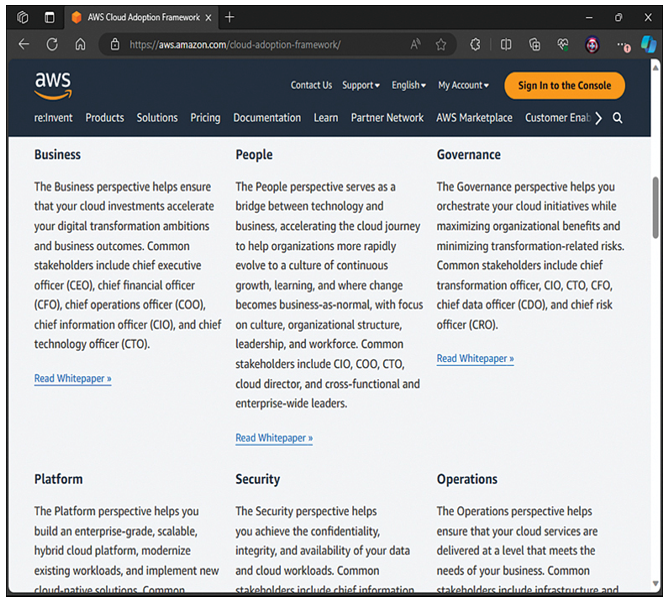The AWS Cloud Adoption Framework
As AWS continues to grow in scale and scope, more and more organizations realize that they should make a move to cloud technologies to stay competitive and perhaps even to expand and improve their business offerings. To help these organizations make the move to the AWS Cloud successfully, AWS offers the Cloud Adoption Framework (CAF). Using this framework provides many advantages, including the following:
Reducing the business risk after a cloud migration
Improved environmental, social, and governance (ESG) performance
Increased revenue
Increased operational efficiency
How can such remarkable advantages be achieved? AWS identifies what it calls a cloud transformation value chain in the CAF. This value chain describes the power of transforming technology, processes, organizations, and products:
Technological transformation: This is an appropriate starting point and probably represents exactly what you think about when you envision a cloud migration. Thanks to the cutting-edge nature of AWS technologies, you have the ability to modernize (maybe even revolutionize) your use of technology in the cloud compared to what you can achieve on premises.
Process transformation: This area highlights the digitalization, automation, and enhancement of your business operations. Maybe thanks to the AWS migration, your company will start leveraging big data and data analytics after struggling mightily to try to achieve this using its own technologies. Many organizations report that a successful AWS migration enables them to enhance operational efficiency, reduce operating costs, and elevate both employee and customer experiences.
Organizational transformation: A successful migration to the AWS Cloud may permit a company to improve its operations due to the freedom and flexibility the public AWS Cloud provides even the smallest of businesses.
Product transformation: Migrating to the AWS Cloud can be very exciting for companies that believe their products or services are stale. When you leverage the power of AWS to create new products or services, you may be able to gain new customers or generate new revenue streams that you can use to improve your overall business performance.
Foundational Capabilities
Based on what you have now read about the cloud transformation value chain, you are likely excited to make improvements in your own organization. But how do you accomplish this? AWS identifies foundational capabilities that make a successful migration a reality. It organizes these capabilities into six areas called perspectives (see Figure 4-1).

Figure 4-1 Perspectives in the Cloud Adoption Framework
Be sure you are familiar with these perspectives:
Business: Is your migration to the cloud really improving your business processes and helping you achieve your business goals? Typical stakeholders for this foundational capability in your organization include key C-suite personnel, like the chief executive officer (CEO), chief financial officer (CFO), chief operations officer (COO), chief information officer (CIO), and chief technology officer (CTO).
People: What are technology and business processes without the people who make it all happen? It is important to ensure that there is a culture of innovation and learning among the people in your organization. Key stakeholders in this area include the CIO, COO, CTO, cloud director, and cross-functional and enterprise-wide leaders.
Governance: What about the risks of moving to the cloud from a rules and policies perspective? The governance foundational capability is all about minimizing the potential risks to your governance initiatives. Typical stakeholders in this area include the chief transformation officer, CIO, CTO, CFO, chief data officer (CDO), and chief risk officer (CRO).
Platform: What about the really cool stuff of the AWS Cloud—things like autoscaling and high-performance compute and artificial intelligence (AI)? These are part of the platform foundational capability. Traditional on-premises facilities often lack the budgets and the expertise to make these types of platform enhancements a reality. Typical stakeholders in this area include the CTO, technology leaders, architects, and engineers.
Security: Many people in your organization might be concerned about a loss of security with a cloud migration. Just as we are obsessed with the CIA (confidentiality, integrity, and availability) triad in our own networks, we work hard to make this a reality in the AWS Cloud. Common stakeholders include the chief information security officer (CISO), chief compliance officer (CCO), internal audit leaders, and security architects and engineers.
Operations: It is important to ensure that business needs are met by the services and functionality of the AWS Cloud. You do not want to adopt AWS Cloud technologies just because it is the current trend; you want to really address business needs with the technology. Common stakeholders in this area include the infrastructure and operations leaders, site reliability engineers, and information technology service managers.
